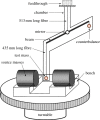G measurements with time-of-swing method at HUST
- PMID: 25202004
- PMCID: PMC4173272
- DOI: 10.1098/rsta.2014.0141
G measurements with time-of-swing method at HUST
Abstract
We review the G measurements with time-of-swing method at HUST. Two independent experiments have been completed and an improved experiment is in progress. The first G value was determined as 6.6699(7)×10-11 m3 kg-1 s-2 with a relative standard uncertainty (ur) of 105 ppm by using a long period torsion pendulum and two cylindrical source masses. Later, this result was corrected to be 6.6723(9)×10-11 m3 kg-1 s-2 with ur=130 ppm after considering the density distribution of the cylinders and the air buoyancy, which was 360 ppm larger than the previous value. In 2009, a new experiment by using a simple block pendulum and spherical source masses with more homogeneous density was carried out. A series of improvements were performed, and the G value was determined to be 6.67349(18)×10-11 m3 kg-1 s-2 with ur=26 ppm. To reduce the anelasticity of the torsion fibre, fused silica fibres with Q's of approximately 5×104 are used to measure G in the ongoing experiment. These fibres are coated with thin layers of germanium and bismuth in turn to reduce the electrostatic effect. Some other improvements include the gravity compensation, reduction of the coating layer effect, etc. The prospective uncertainty of the next G value is 20 ppm or lower.
Keywords: CODATA; gravitational constant G; precision measurement; time-of-swing method; torsion pendulum.
© 2014 The Author(s) Published by the Royal Society. All rights reserved.
Figures





Similar articles
-
A measurement of G with a cryogenic torsion pendulum.Philos Trans A Math Phys Eng Sci. 2014 Oct 13;372(2026):20140025. doi: 10.1098/rsta.2014.0025. Epub 2014 Sep 8. Philos Trans A Math Phys Eng Sci. 2014. PMID: 25202000
-
Determination of the Newtonian gravitational constant G with time-of-swing method.Phys Rev Lett. 2009 Jun 19;102(24):240801. doi: 10.1103/PhysRevLett.102.240801. Epub 2009 Jun 16. Phys Rev Lett. 2009. PMID: 19658992
-
Preliminary determination of Newtonian gravitational constant with angular acceleration feedback method.Philos Trans A Math Phys Eng Sci. 2014 Oct 13;372(2026):20140031. doi: 10.1098/rsta.2014.0031. Epub 2014 Sep 8. Philos Trans A Math Phys Eng Sci. 2014. PMID: 25201996 Free PMC article.
-
The BIPM measurements of the Newtonian constant of gravitation, G.Philos Trans A Math Phys Eng Sci. 2014 Oct 13;372(2026):20140032. doi: 10.1098/rsta.2014.0032. Epub 2014 Sep 8. Philos Trans A Math Phys Eng Sci. 2014. PMID: 25201995 Review.
-
The attracting masses in measurements of G: an overview of physical characteristics and performance.Philos Trans A Math Phys Eng Sci. 2014 Oct 13;372(2026):20140022. doi: 10.1098/rsta.2014.0022. Epub 2014 Sep 8. Philos Trans A Math Phys Eng Sci. 2014. PMID: 25201999 Review.
Cited by
-
Precision measurement of the Newtonian gravitational constant.Natl Sci Rev. 2020 Jul 22;7(12):1803-1817. doi: 10.1093/nsr/nwaa165. eCollection 2020 Dec. Natl Sci Rev. 2020. PMID: 34691518 Free PMC article.
References
-
- Cavendish H. 1798. Experiments to determine the density of the Earth. Phil. Trans. R. Soc. Lond. 88, 469–526. (10.1098/rstl.1798.0022) - DOI
-
- Gillies GT. 1997. The Newtonian gravitational constant: recent measurements and related studies. Rep. Prog. Phys. 60, 151–225. (10.1088/0034-4885/60/2/001) - DOI
Publication types
LinkOut - more resources
Full Text Sources
Other Literature Sources

